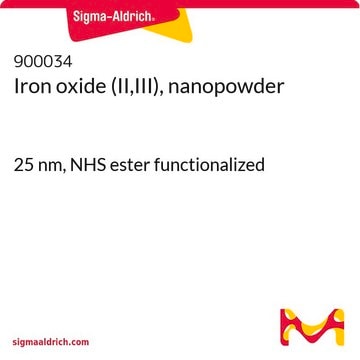Products may be shipped at a different temperature than the recommended long-term storage temperature. If the product quality is sensitive to short-term exposure to conditions other than the recommended long-term storage, it will be shipped on wet or dry-ice. If the product quality is NOT affected by short-term exposure to conditions other than the recommended long-term storage, it will be shipped at ambient temperature. As shipping routes are configured for minimum transit times, shipping at ambient temperature helps control shipping costs for our customers. For more information, please refer to the Storage and Transport Conditions document: https://www.sigmaaldrich.com/deepweb/assets/sigmaaldrich/marketing/global/documents/316/622/storage-transport-conditions-mk.pdf
637106
Iron(II,III) oxide
nanopowder, 50-100 nm particle size (SEM), 97% trace metals basis
Synonyme(s) :
Ferrosoferric oxide, Iron oxide black, Magnetite
Sélectionner une taille de conditionnement
Sélectionner une taille de conditionnement
About This Item
Produits recommandés
Niveau de qualité
Essai
97% trace metals basis
Forme
nanopowder
spherical
Superficie
6-8 m2/g , estimated
Taille des particules
50-100 nm (SEM)
Pf
1538 °C (lit.)
Densité
4.8-5.1 g/mL at 25 °C (lit.)
Masse volumique apparente
0.84 g/mL
Application(s)
battery manufacturing
Chaîne SMILES
O=[Fe].O=[Fe]O[Fe]=O
InChI
1S/3Fe.4O
Clé InChI
SZVJSHCCFOBDDC-UHFFFAOYSA-N
Vous recherchez des produits similaires ? Visite Guide de comparaison des produits
Description générale
Application
Remarque sur l'analyse
Code de la classe de stockage
11 - Combustible Solids
Classe de danger pour l'eau (WGK)
nwg
Point d'éclair (°F)
Not applicable
Point d'éclair (°C)
Not applicable
Équipement de protection individuelle
dust mask type N95 (US), Eyeshields, Gloves
Faites votre choix parmi les versions les plus récentes :
Certificats d'analyse (COA)
Vous ne trouvez pas la bonne version ?
Si vous avez besoin d'une version particulière, vous pouvez rechercher un certificat spécifique par le numéro de lot.
Déjà en possession de ce produit ?
Retrouvez la documentation relative aux produits que vous avez récemment achetés dans la Bibliothèque de documents.
Les clients ont également consulté
Articles
Prof. Randal Lee discusses iron oxide magnetic nanospheres and nanocubes design considerations for biosensing applications.
Magnetic nanoparticles have attracted tremendous attention due to their novel properties and their potential applications in magnetic recording, magnetic energy storage and biomedicine.
An article concerning self-propagating reactions induced by mechanical alloying, presented by Sigma-Aldrich.com.
Graphene is a unique two-dimensional (2D) structure of monolayer carbon atoms packed into a dense honeycomb crystal that has attracted great interest due to its diverse and fascinating properties.
-
How is shipping temperature determined? And how is it related to the product storage temperature?
1 answer-
Helpful?
-
-
How can I determine the shelf life / expiration / retest date of this product?
1 answer-
If this product has an expiration or retest date, it will be shown on the Certificate of Analysis (COA, CofA). If there is no retest or expiration date listed on the product's COA, we do not have suitable stability data to determine a shelf life. For these products, the only date on the COA will be the release date; a retest, expiration, or use-by-date will not be displayed.
For all products, we recommend handling per defined conditions as printed in our product literature and website product descriptions. We recommend that products should be routinely inspected by customers to ensure they perform as expected.
For products without retest or expiration dates, our standard warranty of 1 year from the date of shipment is applicable.
For more information, please refer to the Product Dating Information document: https://www.sigmaaldrich.com/deepweb/assets/sigmaaldrich/marketing/global/documents/449/386/product-dating-information-mk.pdfHelpful?
-
-
what is the Iron concentration in ug/ul of Product 637106?
1 answer-
This product is in powder form. The density is 4.8-5.1 g/mL at 25 °C (lit.), with an average of 4.95 g/mL. The iron content is tested on a lot-to-lot basis. For lot# MKCV7594, the iron content is 66.5%, and the purity is 97%. Therefore, the iron concentration is calculated as 4.95 x 66.5% x 97% = 3.19 g/mL = 3190 µg/µL.
Helpful?
-
-
Does this product have paramagnetic properties?
1 answer-
The paramagnetic properties of this product have not been determined.
Helpful?
-
-
How can the nanopowder Iron(II,III) oxide, Product 637106, be dispersed in an aqueous solution?
1 answer-
1. It is recommended to use a neutral buffered solution (approximately pH 7). The pH of the solution is an important factor in achieving a monodispersion of the nanopowder.2. Probe-type ultrasonication is strongly recommended by the manufacturer.3. If the material is not well dispersed by ultrasonication in a neutral buffer, add a surfactant. This will wet the nanoparticle surface. Since the particles are small (less than 50 nm), they have a high surface area to volume ratio. They can therefore absorb gases such as oxygen or carbon dioxide from the air, which would decrease the dispersity of the particles. Degassing the buffer before use may help to eliminate the formation of gas bubbles.
Helpful?
-
-
What is the Department of Transportation shipping information for this product?
1 answer-
Transportation information can be found in Section 14 of the product's (M)SDS.To access the shipping information for this material, use the link on the product detail page for the product.
Helpful?
-
-
What is the particle sizeof Product 637106, Iron(II,III) oxide?
1 answer-
Average particle sizes are 50-100 nm.
Helpful?
-
-
Is Product 637106, Iron(II,III) oxide, stabilized (coated)?
1 answer-
No, product 637106 has not been coated on the surface per the supplier.
Helpful?
-
Active Filters
Notre équipe de scientifiques dispose d'une expérience dans tous les secteurs de la recherche, notamment en sciences de la vie, science des matériaux, synthèse chimique, chromatographie, analyse et dans de nombreux autres domaines..
Contacter notre Service technique






